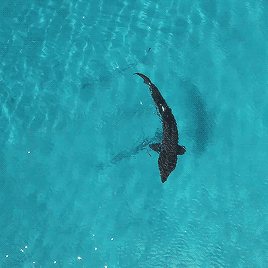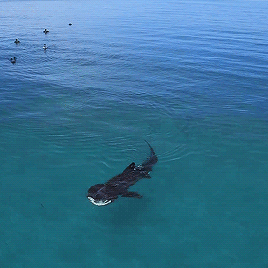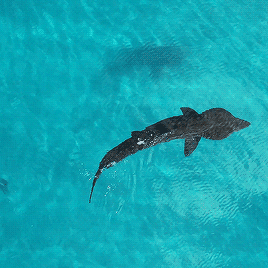Sawfish Sharks,of The Order (Pristiformes) Of Rays Characterized By A Long, Narrow, Flattened Rostrum,

Sawfish sharks,of the order (Pristiformes) of rays characterized by a long, narrow, flattened rostrum, or nose extension, lined with sharp transverse teeth, arranged so as to resemble a saw. All species of sawfish are endangered or critically endangered due to over fishing or habitat loss.
More Posts from Llamaslikesciencetoo and Others





Mysterious Deep-Sea Animal Rediscovered after 116 Years
http://www.sci-news.com/biology/bathochordaeus-charon-04426.html
I always get really…touchy, when someone says they want to go into marine biology for the whales. I admire their love for the ocean and the mammals living within it, but I also get frustrated with their naivety. A degree doesn’t guarantee any kind of field work.
In fact, it’s a hell of lot of work to be able to do any kind of field work, and even less likely for it to be marine mammal related. I spent one semester on marine mammals. Just 16 weeks, and half the experiences I had with strandings and training and dissections came with my location and pure happenstance.
Marine biology isn’t whales. It’s becoming a statistician with a deeply routed knowledge on marine ecosytems and processes. I didn’t spend four years working through the blood, sweat, and tears for this degree to listen to someone complain about not being able to pet a dolphin when they graduate.


KELP FOREST REPLACE CORALS IN THE MEDITERRANEAN
A decrease from pH 8.1 to 7.9 observed in a CO2 vent system at 40 m depth leads to a dramatic shift in highly diverse and structurally complex habitats.
Rising levels of CO2 released by anthropogenic activities are driving unprecedented changes in the chemistry of the oceans. The mean ocean surface acidity has increased by 25–30% (equivalent to a drop of 0.1 pH units) since as the advent of the Industrial Revolution in the 1780s and is predicted to decline by a further 150–200% by the end of the century.
Ocean acidification is one of the greatest long-term challenges facing the survival of reefs and coral. Habitats widely distributed in the Mediterranean, such as coral colonies and maerl environments, characterized by the predominance of calcareous organisms, are relegated by Laminaria rodriguezii forests.
Dominant habitats at mesophotic depths (the deepest part of the photic zone where light penetration is low, typically from 30–40 m to over 150 m) are usually characterized by a large dominance of calcifying organisms, such as endangered coralligenous outcrops and rhodolith beds in the Mediterranean Sea, which display a notable carbonate production. Calcareous red algae are the main framework builders in those two habitats, providing structural complexity and favouring biodiversity
Reference: Linares et al. 2015. Persistent natural acidification drives major distribution shifts in marine benthic ecosystems. Proc. R. Soc. B



This new procedure is making it a little bit easier to deal with cancer treatment
Cancer patients who are undergoing chemo no longer have to suffer hair loss. A new cooling treatment, called the Dignicap, is placed on the head during chemo and protects the hair follicle by reducing blood flow. The process can be expensive, sometimes up to $600, but so far it’s been very effective and has helped cancer patients feel a little more comfortable throughout their treatment.

Climate change could kill 534,000 people in 2050
If you’ve ever needed a statistic to slap you in the face to make you give a damn about climate change, this is it: A new report from The Lancet estimates more than 500,000 adults could die in 2050, thanks to how climate change will kill crop productivity, altering the diets and available food all over the world.
Follow @the-future-now

x

SPERM WHALE EVOLVED TO RAMMING
Herman Melville’s novel Moby Dick was inspired by historical instances in which large sperm whales (Physeter macrocephalus L.) sank 19th century whaling ships by ramming them with their foreheads. The immense forehead of sperm whales is possibly the largest, and one of the strangest, anatomical structures in the animal kingdom. It contains two large oil-filled compartments, known as the “spermaceti organ” and “junk,” that constitute up to one-quarter of body mass and extend one-third of the total length of the whale
Now an international team of researchers used structural engineering principles to test how the head of the sperm whale might be able to resist strong ramming impacts. Using computer simulations and working from published data on sperm-whale tissue and skeletal structure, scientists modeled impacts of varying types, and from a range of directions,what they found is the whale’s junk proved to play a vital role, with tissue partitions distributing much of the stress from ramming impacts and thereby preventing the skull from fracturing.
Although male sperm whales may not fight frequently, we know that aggressive ramming behaviour is a common characteristic in the group of mammals from which whales are derived – the even-toed ungulates, the artiodactyls.
Illustration: Schematic representation of sperm whale head structure, courtesy of Ali Nabavizadeh.
Reference: Panagiotopoulou et al. 2016. Architecture of the sperm whale forehead facilitates ramming combat Peerj


Ancient ‘otter bear’ may have popped clams off rocks like a bottle opener
By Sid Perkins
A creature that roamed the coasts of the Pacific Northwest about 20 million years ago may have had a feeding style like no other mammal, a new study suggests.
Kolponomos is known only from two bearlike skulls, jawbones, and some toe bones found a few decades ago, so scientists aren’t sure where it fits on the carnivore family tree or even what it really looked like (one artist’s idea is seen above).
Rather than having cheek teeth that could shear meat, as many carnivores do, Kolponomos’s molars were similar to the flattened, low-crowned teeth that otters use to crush their shelled prey—yet the creature lived long before anything similar to modern-day otters evolved.
Now, a new analysis using the same sort of computer software that engineers employ to analyze bridges and aircraft parts suggests that Kolponomos may have collected its shelly prey in a unique way…
(read more: Science Magazine/AAAS)
illustration by Roman Uchytel



The Silent Flying of an Owl.
The video shows how effortlessly an owl fly’s compared to other bird species.
A pigeon that has a relatively large body and small wings needs to flap furiously to produce enough lift. A falcon has large wings that move more aggressively so the bird can gain much faster speeds.
Both birds create large turbulence in the air and noise as a result. Comparatively, the owl is the perfect night time hunter, silently flying through the sky.
-
 llamaslikesciencetoo reblogged this · 9 years ago
llamaslikesciencetoo reblogged this · 9 years ago -
 alicia-logic liked this · 9 years ago
alicia-logic liked this · 9 years ago -
 llamafollower liked this · 9 years ago
llamafollower liked this · 9 years ago -
 tangledwing reblogged this · 9 years ago
tangledwing reblogged this · 9 years ago
Mainly interested in ecology, but also the entirety of science.
179 posts